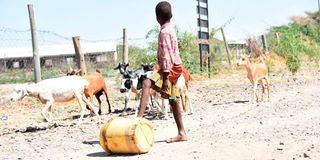How to transform Turkana County

A gilrl pushes a jerrican of water at Lowareng’ak village in Turkana County on October 12, 2022 amid a biting drought.
Turkana County experiences inadequate or complete rain failures every other season, causing mass deaths of livestock and heavy losses to pastoralist households.
Since cattle, goats, sheep, donkeys and camels are the main source of livelihood, widespread famine ravages the region on a regular vasis.
Past studies have, however, shown that Turkana households are impacted differently by drought. Those households that have cash from whatever source can access food from local shopping centres and thus keep famine at bay. It is those that have no money that become the main victims of drought and famine. For these households, the perennial food crisis is real and looms large. This understanding helps us to see the drought problem as having two dimensions: One, over-dependence on livestock as the principal source of livelihood and two, limited local capacity for confronting the drought hazard.
What can Turkana do differently to avert the perennial famine?
The county has received more research attention on drought causes, consequences and coping strategies than any of the other 46 in Kenya. Regrettably, most of the recommendations from these studies tend to be timid, incremental and short-term.
To face the drought menace head-on, there is need for a radical shift in the way the problem is diagnosed and solutions prescribed. A parallel can be drawn with past revolutions in history, such as the Industrial Revolution in Britain (1760-1860), Meiji Revolution in Japan (1868-1912), Bolshevik Revolution in Russia (1917-1923) and the Chinese Revolution (1927-1949).
A Turkana revolution can be expected to achieve two ultimate goals. One, the county to have a diversified economy featuring value addition on its broad range of resources; livestock, water aquifer, minerals, renewable energy (wind, solar, geothermal) and tourism potential. Two, with diversification, the county economy to create new job opportunities and livelihoods.
The organising ideology of the suggested revolution is fairly simple: relentless acquisition of knowledge, skills and relevant technology as well as the collective will to use technology for transforming and adding value to the county’s resources.
Like the rest of Kenya, perhaps a little more so, Turkana labours under the tragedy of severe technological impotence. This is so in spite of receiving massive injections of donor and government support.
Erratic rainfall
To put things in perspective, it might be instructive to compare a country with similar environmental challenges as Turkana. Israel, just like Turkana, has low and erratic rainfall.
Israel’s land area is 22,000 sq kms with a population of eight million, as compared to Turkana’s 77,000 sq kms and a population of one million. Occurrence of geological resources are similar: fossil fuel (gas or oil, surface and underground water reservoirs), a wide range of industrial minerals (gold, copper, lime gypsum and gemstones), surface water resources (lakes, permanent and seasonal rivers). But the similarities stop there.
Now the differences. Israeli people have installed a master water distribution network that serves domestic, industrial, livestock and irrigation needs. A mix of technologies is at the core of this accomplishment, including water desalination.
Turkana society lacks command of such technologies. By contrast, Israel inhabitants are not only self-sufficient in food, but export a surplus to the rest of the world, including Kenya.
To succeed in applying technology on its natural resources, a Turkana Revolution is likely to prioritise the following areas:
The top priority is investment in education, including adult education, particularly targeted at women.
Second, build a technical university at Lodwar for diploma and degree-level training in a range of disciplines relevant to value addition of existing resources in the county including water engineering, geology and mining, livestock and fisheries, mechanical and civil engineering, renewable energy technologies.
The third priority is to establish well-equipped and staffed TVET centres.
The fourth intervention is updating of the inventory of the county’s natural resources as well a livestock census
Fifth, identify areas with tourism potential such as Olduvai Gorge, hot springs, lake Turkana and Turkwel Dam.
The sixth priority is to document renewable energy potential, including wind, solar and geothermal.
Seven, establish a County Department responsible for strategic communication about the ongoing technological revolution.
Eight, convince the central government to ensure security of the county.
With a full complement of technologically empowered women and men, all the ingredients of a Turkana economic takeoff will be there.
The writer is a rural development consultant and a director at Kakuzi Plc





